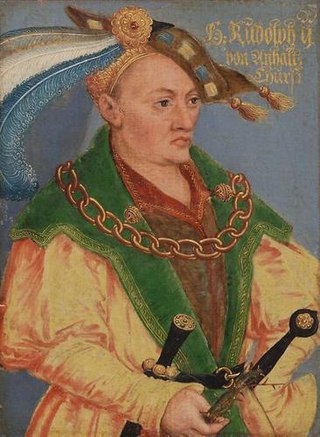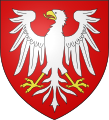
Heinrich of Saxe-Weissenfels, Count of Barby, was a German prince of the House of Wettin and count of Barby.

Georg Albrecht of Saxe-Weissenfels, Count of Barby, was a German prince of the House of Wettin and the last count of Barby.

Johann Christoph Volkamer was a German merchant, manufacturer and botanist.

The County of Sponheim was an independent territory in the Holy Roman Empire that lasted from the 11th century until the early 19th century. The name comes from the municipality of Sponheim, where the counts had their original residence.

The County of Stolberg was a county of the Holy Roman Empire located in the Harz mountain range in present-day Saxony-Anhalt, Germany. It was ruled by a branch of the House of Stolberg.

The County of Wernigerode was a state of the Holy Roman Empire which arose in the Harzgau region of the former Duchy of Saxony, at the northern foot of the Harz mountain range. The comital residence was at Wernigerode, now part of Saxony-Anhalt, Germany. The county was ruled by a branch of the House of Stolberg from 1429 until its mediatization to the Kingdom of Prussia in 1806. Nevertheless, the county remained in existence - with one short interruption - until the dissolution of the Kingdom of Prussia in 1918.
George I, Prince of Anhalt-Dessau, was a German prince of the House of Ascania and ruler of the principality of Anhalt-Dessau. He was the second son of Sigismund I, Prince of Anhalt-Dessau, by his wife Judith, daughter of Gebhard XI, Count of Querfurt.

John V of Anhalt-Zerbst, was a German prince of the House of Ascania and ruler of the principality of Anhalt-Dessau. From 1544, he assumed rule of the re-created principality of Anhalt-Zerbst.
Stephen I, Count of Sponheim is the patriarch of the Rhenish branch of the House of Sponheim, which ruled over the County of Sponheim. He was closely related to Siegfried I, Count of Sponheim, patriarch of the Carinthian Sponheimish branch, but the exact relationship between the two dynasts is disputed. Johannes Trithemius credits a Count Eberhard of Sponheim as founder of the Abbey of Sponheim and dates the founding to 1044, a position questioned by Johannes Mötsch. The Genealogia Sponhemica presents Count Eberhardus as son of Countess Hedwig and father of a single Count Stephenus I/II of Sponheim. Donald C. Jackman considers Stephen I a son of Siegfried I. Both Jackman and Josef Heinzelmann consider Stephen as being identical to Stephen, Vogt of Worms documented with his brother Markward in 1068. Heinzelmann however casts doubt on a male lineage relationship of Stephen and Siegfried and sees Stephen I of Sponheim as being Lord of Sponheim but not a Count, notices that Stephen I of Sponheim is documented in 1075 as "S(igna) Stepheni de Spanheim" with his seal in a document of Udo, Archbishop of Trier, and proposes Stephen to have married into the House of Sponheim. In another work Heinzelmann considers the Stephen mentioned in 1075 to be Stephen II, or maybe a single Stephen, mentions a Mainzer ministerialis Stephen, the son of Embricho (Emich) and nephew of Archbishop Ruthard, who lived later, as a possible relation, and puts forward that the documented Stephen and Markward belong to the House of the Counts of Metz/Lunéville, which later provided the Vogts of Worms:
"Identisch kann er sein mit einem Wormser Vogt Stephen (1068) [239 UB Stadt Worms I, Nr. 55], der mit seinem Bruder Markwart zu den Grafen von Lunéville/Metz zu gehören scheint, die mit den de Meti später die Wormser Vögte stellen."

the Regenstein family, also Reinstein, was a Lower Saxon noble family, which was named after the eponymous Regenstein Castle near Blankenburg on the edge of the Harz Mountains of central Germany.
Elisabeth of Anhalt was a German abbess of the secular abbeys at Gernrode and Frose as Elisabeth III of Anhalt. After she left the convent, she became Countess of Barby by marriage.

Rudolf I, a member of the House of Ascania, was Duke of Saxe-Wittenberg from 1298 until his death. By the Golden Bull of 1356 he was acknowledged as Elector of Saxony.

Rudolf II, Duke of Saxe-Wittenberg, nicknamed Rudolf the Blind, was a member of the House of Ascania. He was Elector of Saxony and Duke of Saxe-Wittenberg from 1356 until his death. He was the eldest son of Duke Rudolf I of Saxe-Wittenberg and his wife, Judith of Brandenburg-Salzwedel.

Albert Anton, Prince of Schwarzburg-Rudolstadt was the ruling Count of Schwarzburg-Rudolstadt from 1662 to 1710. He was raised to Imperial Prince in 1697, however, he chose not to accept his elevation. In 1710, he was elevated again, and this time, he accepted.
Helmhold III, Count of Schwerin was a German nobleman. He was a son of Count Gunzelin III of Schwerin-Boizenburg and Margaret of Mecklenburg. Helmhold III was the ruling Count of Schwerin-Neustadt and Marnitz from 1274 until his death.

The County of Moers was a historical princely territory on the left bank of the Lower Rhine that included the towns of Moers and Krefeld as well as the surrounding villages and regions.
Michael Ranft, in Latin Michael Ranfftius was a Lutheran pastor, writer and historian who is known for his writings on vampires in Germany.

The Lordship of Ruppin was a feudal lordship of the Holy Roman Empire centered around the town of Neuruppin.The Lords of Ruppin held up residence in Castle Ruppin since 1240. The lordship was under the rule of Lindow-Ruppin family from about 1214 until 1524 before being annexed by the Margraviate of Brandenburg.

The County of Steinfurt, originally the Lordship of Steinfurt, was a historic territory of the Holy Roman Empire in the Münsterland. It existed from roughly 1100 until 1806.


























